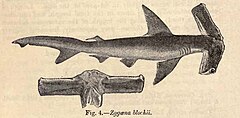Winghead shark
| Winghead shark | |
|---|---|

| |
| Scientific classification | |
| Kingdom: | |
| Phylum: | |
| Class: | |
| Subclass: | |
| Order: | |
| Family: | |
| Genus: | Eusphyra Gill, 1862
|
| Species: | E. blochii
|
| Binomial name | |
| Eusphyra blochii (Cuvier, 1816)
| |

| |
| Range of the winghead shark | |
| Synonyms | |
|
Zygaena latycephala van Hasselt, 1823 | |
The winghead shark (Eusphyra blochii) is a species of hammerhead shark, family Sphyrnidae, named for the remarkably wide lobes on its head. It is the sole species in the genus Eusphyra. A small and harmless species, the winghead shark is commercially fished throughout much of its range.
Taxonomy and phylogeny
Georges Cuvier first described a specimen of the winghead shark in 1817, as a footnote to his account of Squalus zygaena (=Sphyrna zygaena, the smooth hammerhead). Although his citation was not a proper binomial name, Valenciennes interpreted it as Zygaena Blochii nobis when he described and illustrated the winghead shark in detail in 1822.[2] Compagno (1979, 1988) elevated the winghead shark to its own genus, Eusphyra, although this was disputed by Dingerkus (1986) on the grounds that it made the genus Sphyrna paraphyletic. Since then, the winghead shark has been listed under its own genus or as a subgenus of Sphyrna in various sources.[3]
| Phylogenetic relationships of hammerhead sharks, based on morphology, isozymes, and mitochondrial DNA.[4] |
A phylogenetic analysis based on mitochondrial DNA by Martin (1993) showed that, contrary to the traditional (and intuitive) interpretation that the hammerheads with small "hammers" (such as the bonnethead) represented intermediate forms between the requiem sharks and those species with larger "hammers", the winghead shark was in fact the earliest of the hammerheads to diverge from their carcharhinid ancestors. This suggests that the large hammer appeared suddenly in evolutionary history, and was later modified in the other species.[3]
Distribution and habitat
The winghead shark is found in shallow water on the continental and insular shelves of the Indo-West Pacific, from the Persian Gulf to the Philippines, north to China and Taiwan, and south to Queensland and the Northern Territory of Australia.[2] It sometimes enters the brackish water of estuaries.[5]
Description
The extremely long and narrow lateral head blades of the winghead shark, called a "cephalofoil", distinguishes this shark from all other species. The width of the cephalofoil is 40-50% the body length; it is wing or arrow-shaped from above, with small bumps in front of the nostrils. Unlike in Sphyrna, the nostrils are placed closer to the center of the cephalofoil than the ends, and have enormous lateral extensions that reach almost to the eyes. Its coloration is grey or grey-brown above, paler below.[2] This is a small shark, not more than 1.86 m long.[5]
Biology and ecology
The cephalofoil of the winghead shark is so large as to be almost unwieldy, while the placement of the nostrils and the ampullae of Lorenzini are wider than in non-hammerhead sharks (albeit more medial than in other hammerhead sharks). Along with its basal position in hammerhead phylogeny, this lends support to the idea that this structure originally evolved for a sensory, rather than hydrodynamic, function.[3] The winghead shark feeds mainly on small teleost fishes, but also takes crustaceans and cephalopods.[5]
Like other hammerhead sharks, the winghead shark is viviparous with the embryos nourished by a yolk sac placenta. Off Bombay, the young are birthed just before the monsoon season in April and May and mating takes place during the monsoon from June to August, suggesting a gestation period of eight months.[2] Off Australia, the females give birth in February and March, after a gestation period of 10-11 months.[6] Litters number 6 to 25 pups,[5] with the young measuring 32-45 cm at birth.[2] Females reproduce every year.[6] Maturation occurs at around 110 cm.[1]
Human interactions
The winghead shark is probably harmless to humans. It is a common fisheries species in India, Pakistan, Malaysia and Thailand, and probably also in other parts of its range. It is caught with floating gillnets, fixed bottom gill nets, stake nets, seines, with floating and bottom longlines, and probably on hook-and-line.[2] It is particularly common in catches off Kalimantan,[5] and comprise a small part of Australian commercial catches.[1] The meat is used for human consumption, the liver is a source of high-potency vitamin oil, and the offal is probably used for fishmeal.[2] There is no scientific data on its population status, though anecdotal accounts and market surveys suggest that it has likely declined in most of its range except Australia.[1]
References
- ^ a b c d Template:IUCN2006
- ^ a b c d e f g Compagno, Leonard J. V. (1984) Sharks of the World: An Annotated and Illustrated Catalogue of Shark Species Known to Date. Rome: Food and Agricultural Organization. ISBN 92-5-101384-5.
- ^ a b c Martin, R. Aidan. (February 24, 1998). Recent Changes in Hammerhead Taxonomy. ReefQuest Centre for Shark Research. Retrieved on October 18, 2008.
- ^ Cavalcanti, M.J. (2007). "A Phylogenetic Supertree of the Hammerhead Sharks (Carcharhiniformes: Sphyrnidae)". Zoological Studies. 46 (1): 6–11.
- ^ a b c d e Froese, Rainer; Pauly, Daniel (eds.). "Eusphyra blochii". FishBase. May 2006 version.
- ^ a b Stevens, J.D. and Lyle, J.M. (1989). "Biology of three hammerhead sharks (Eusphyra blochii, Sphyrna mokarran and S. lewini) from Northern Australia". Australian Journal of Marine and Freshwater Research. 40 (2): 129–146. doi:10.1071/MF9890129.
{{cite journal}}:|access-date=requires|url=(help)CS1 maint: multiple names: authors list (link)

